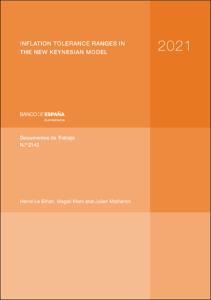Inflation tolerance ranges in the new keynesian model
Autor
Fecha de publicación
2-dic-2021
Descripción física
44 p.
Resumen
Los bancos centrales de varios países avanzados utilizan rangos, o bandas, en torno a su objetivo de inflación para formular su estrategia de política monetaria. La adopción de estos rangos ha sido propuesta por algunos responsables de política monetaria en el contexto de las revisiones de la estrategia de la Fed y del BCE. Utilizando un modelo macroeconómico neokeynesiano estándar, analizamos las consecuencias de las políticas de rangos de tolerancia, caracterizadas por una reacción más fuerte del banco central a la inflación cuando esta se encuentra fuera del rango que cuando está cerca del objetivo, es decir, del valor central de la banda. Demostramos que: i) una banda de tolerancia no debería ser una zona de inacción: la falta de reacción dentro de la banda pone en peligro la estabilidad macroeconómica y conduce a la posibilidad de múltiples equilibrios; ii) el trade-off entre la reacción necesaria fuera de la banda y dentro de ella parece desfavorable: cuando la inflación está lejos del objetivo, se requiere una reacción muy fuerte para compensar una reacción moderadamente menor dentro de la banda de tolerancia, y iii) estos resultados, obtenidos en el marco de un modelo estilizado, son robustos a muchas alteraciones, en particular a la imposición de un límite inferior a los tipos de interés.
A number of central banks in advanced countries use ranges, or bands, around their inflation target to formulate their monetary policy strategy. The adoption of such ranges has been proposed by some policymakers in the context of the Fed and the ECB reviews of their strategies. Using a standard New Keynesian macroeconomic model, we analyze the consequences of tolerance range policies, characterized by a stronger reaction of the central bank to inflation when inflation lies outside the range, than when it is close to the target, i.e., the central value of the band. We show that (i) a tolerance band should not be a zone of inaction: the lack of reaction within the band endangers macroeconomic stability and leads to the possibility of multiple equilibria; (ii) the trade-off between the reaction needed outside the range versus inside appears unfavorable: a very strong reaction, when inflation is far from the target, is required to compensate for a moderately lower reaction within tolerance band; (iii) these results, obtained within the framework of a stylized model, are robust to many alterations, in particular allowing for the zero lower bound.
A number of central banks in advanced countries use ranges, or bands, around their inflation target to formulate their monetary policy strategy. The adoption of such ranges has been proposed by some policymakers in the context of the Fed and the ECB reviews of their strategies. Using a standard New Keynesian macroeconomic model, we analyze the consequences of tolerance range policies, characterized by a stronger reaction of the central bank to inflation when inflation lies outside the range, than when it is close to the target, i.e., the central value of the band. We show that (i) a tolerance band should not be a zone of inaction: the lack of reaction within the band endangers macroeconomic stability and leads to the possibility of multiple equilibria; (ii) the trade-off between the reaction needed outside the range versus inside appears unfavorable: a very strong reaction, when inflation is far from the target, is required to compensate for a moderately lower reaction within tolerance band; (iii) these results, obtained within the framework of a stylized model, are robust to many alterations, in particular allowing for the zero lower bound.
Publicado en
Documentos de Trabajo / Banco de España, 2142
Materias
Estrategia de política monetaria; Rangos de tolerancia de inflación; Bandas de inflación; Límite inferior a los tipos de interés; Cambios de régimen endógenos; Monetary policy; Inflation ranges; Inflation bands; Zero lower bound (ZLB); Endogenous regime switching; Bancos centrales y otras autoridades monetarias; Política monetaria; Fluctuaciones y ciclos económicos
Aparece en las colecciones:












